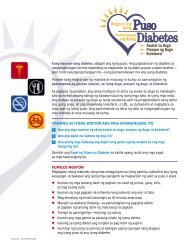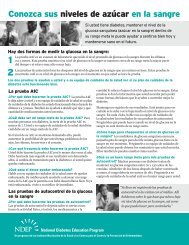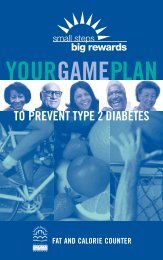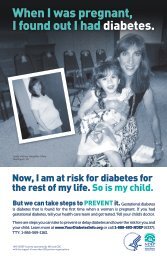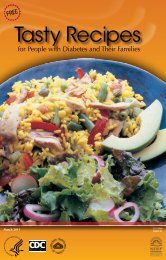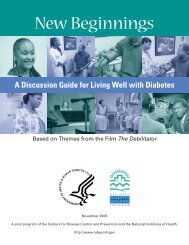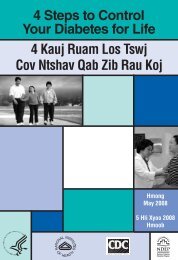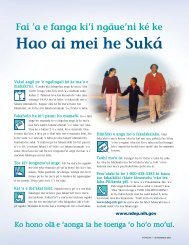Power to Prevent - National Diabetes Education Program - National ...
Power to Prevent - National Diabetes Education Program - National ...
Power to Prevent - National Diabetes Education Program - National ...
Create successful ePaper yourself
Turn your PDF publications into a flip-book with our unique Google optimized e-Paper software.
in silence. Suggest that if participants would like assistance because they have forgotten reading<br />
glasses or for any other reason, you (or your helpers) can assist them. Remind participants <strong>to</strong> write<br />
their names (or initials with their day and month of birth) on the questionnaire and <strong>to</strong> hand them<br />
in <strong>to</strong> you. Be sure <strong>to</strong> collect all questionnaires so that you can pho<strong>to</strong>copy them and return them <strong>to</strong><br />
participants at a future session.<br />
Explain that these questionnaires help you determine the needs of the group and how <strong>to</strong> focus the<br />
discussion and activities in future sessions.<br />
Consider scheduling a group review of the questionnaires as an optional activity for one or more<br />
sessions. If possible, arrange for a health care provider <strong>to</strong> join a session <strong>to</strong> review common questions<br />
raised in the questionnaires.<br />
Discussion Points<br />
Say: “Physical activity is important in losing or maintaining weight, which is an important element in<br />
preventing or delaying type 2 diabetes. Physical activity also helps people with diabetes control their<br />
blood glucose (sugar). Before jumping in<strong>to</strong> any activity or exercise, it is important <strong>to</strong> check with your<br />
doc<strong>to</strong>r. Barring any other medical conditions, most people with diabetes or at risk for diabetes can<br />
do moderate intensity physical activity (like brisk walking). But your doc<strong>to</strong>r may recommend some<br />
limitations.<br />
Physical activity does not mean that you have <strong>to</strong> run marathons or use special exercise equipment.<br />
You can be physically active while doing ordinary chores around the house or while playing with your<br />
children. Remember in the DDP it was important <strong>to</strong> get in at least 30 minutes of moderate intensity<br />
physical activity (like brisk walking) 30 minutes 5 days a week.”<br />
Ask group members <strong>to</strong> name some of the benefts of physical activity. Write their ideas on the<br />
fipchart. Be sure that the following benefts are mentioned:<br />
<strong>Prevent</strong>ing and delaying type 2 diabetes<br />
Lowering and controlling blood glucose (sugar) levels<br />
Reducing the risk for stroke and heart attack<br />
Strengthening heart, lungs, and bones<br />
Lowering blood pressure<br />
Helping with weight control and body fat<br />
Improving circulation<br />
Reducing stress<br />
Reducing feelings of depression and anxiety<br />
Lifting spirits<br />
Say: “I’m going <strong>to</strong> ask some questions, and let’s brains<strong>to</strong>rm the answers <strong>to</strong>gether.”<br />
Ask each of the following questions, and note responses on the fipchart. Facilitate the discussion so<br />
that the key points listed below each question are brought out.<br />
NDEP <strong>Power</strong> <strong>to</strong> <strong>Prevent</strong> Session 4 4



